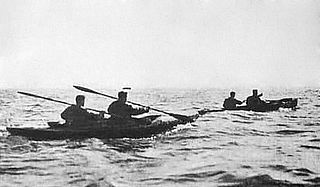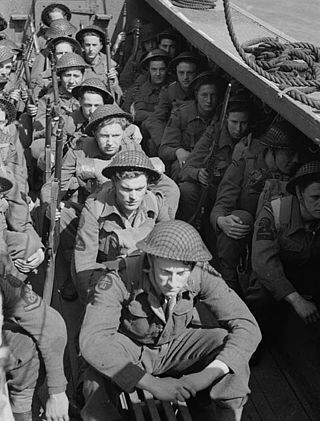Related Research Articles

The Commandos, also known as the British Commandos, were formed during the Second World War in June 1940, following a request from Winston Churchill, for special forces that could carry out raids against German-occupied Europe. Initially drawn from within the British Army from soldiers who volunteered for the Special Service Brigade, the Commandos' ranks would eventually be filled by members of all branches of the British Armed Forces and a number of foreign volunteers from German-occupied countries. By the end of the war 25,000 men had passed through the Commando course at Achnacarry. This total includes not only the British volunteers, but volunteers from Greece, France, Belgium, Netherlands, Canada, Norway, Poland, and the United States Army Rangers and US Marine Corps Raiders, which were modelled on the Commandos.
Layforce was an ad hoc military formation of the British Army consisting of a number of commando units during the Second World War. Formed in February 1941 under the command of Colonel Robert Laycock, after whom the force was named, it consisted of approximately 2,000 men and served in the Middle Eastern theatre of operations. Initially tasked with conducting raiding operations to disrupt Axis lines of communication in the Mediterranean it was planned that they would take part in operations to capture the Greek island of Rhodes.

Operation Jubilee or the Dieppe Raid was an Allied amphibious attack on the German-occupied port of Dieppe in northern France, during the Second World War. Over 6,050 infantry, predominantly Canadian, supported by a regiment of tanks, were put ashore from a naval force operating under protection of Royal Air Force (RAF) fighters.

Special forces or special operations forces (SOF) are military units trained to conduct special operations. NATO has defined special operations as "military activities conducted by specially designated, organized, selected, trained and equipped forces using unconventional techniques and modes of employment".
No. 7 Commando was a unit of the British Commandos and part of the British Army during the Second World War. The commando was formed in August 1940 in the United Kingdom. No. 7 Commando was transferred to the Middle East as part of Layforce. Committed to the Battle of Crete, it suffered heavy casualties, after which it was disbanded.
No. 11 (Scottish) Commando was a battalion-sized commando unit of the British Army during the Second World War. Formed in Scotland, members of No. 11 (Scottish) Commando adopted the Tam o'shanter as their official headdress.

No. 10 (Inter-Allied) Commando was a commando unit of the British Army during the Second World War, recruited largely from non-British personnel from German-occupied Europe. This unit was used to help co-ordinate attacks with other allied forces.
No. 2 Commando was a battalion-sized British Commando unit of the British Army during the Second World War. The first No.2 Commando was formed on 22 June 1940 for a parachuting role at Cambrai Barracks, Perham Down, near Tidworth, Hants. The unit at the time consisted of four troops: 'A', 'B', 'C' and 'D'. Eventually 11 troops were raised. On 21 November, it was re-designated as the 11th Special Air Service (SAS) Battalion and eventually re-designated 1st Parachute Battalion. After their re-designation as the 11th SAS Battalion, a second No. 2 Commando was formed. This No. 2 Commando was the leading commando unit in the St Nazaire Raid and suffered heavy casualties. Those who made it back from St Nazaire rejoined the few who had not gone on the raid, and the commando was reinforced by the first intake of volunteers from the new Commando Basic Training Centre at Achnacarry. No. 2 Commando then went on to serve in the Mediterranean, Sicily, Yugoslavia, and Albania, before being disbanded in 1946.
No. 50 Commando was a battalion-sized British Commando unit of the British Army during the Second World War. The commando was formed in 1940, from volunteers in Egypt and Palestine. Shortly after formation it was amalgamated with No. 52 Commando and became 'D' Battalion, Layforce.
No. 52 Commando was a battalion-sized British Commando unit of the British Army during the Second World War. The commando was formed in 1940, from volunteers in Egypt and Palestine. Shortly after formation it was amalgamated with No. 50 Commando and became 'D' Battalion, Layforce.
Operation Forfar was the name given to a series of British Commando raids on the French coast during World War II. The raids were part of Operation Starkey, a military deception intended to draw out the Luftwaffe. The purpose of these raids was to identify German coastal units and to gain technical intelligence on German equipment, creating the impression of pre-invasion reconnaissance.

The Commandos formed during the Second World War, following an order from the British Prime Minister Winston Churchill in June 1940 for a force that could carry out raids against German-occupied Europe. Churchill stated in a minute to General Ismay on 6 June 1940: "Enterprises must be prepared, with specially-trained troops of the hunter class, who can develop a reign of terror down these coasts, first of all on the "butcher and bolt" policy..." Commandos were all volunteers for special service and originally came from the British Army but volunteers would eventually come from all branches of the United Kingdom's armed forces and foreign volunteers from countries occupied by the Germans. These volunteers formed over 30 individual units and four assault brigades.
No. 14 (Arctic) Commando sometimes also called the Special Commando Boating Group, was a 60-man Commando unit of the British Army during the Second World War. The commando was formed in 1942 for service in the Arctic and was disbanded in 1943.

Operation Myrmidon was the planned raid during the Second World War by No. 1 Commando and No. 6 Commando in April 1942. This operation was an abortive raid on the Adour Estuary in south-western France. The plan was to disrupt road and rail transport between France and Spain by landing approximately 3,000 troops, consisting of two commandos, No. 1 and No. 6, who would be followed up by one and a half Royal Marine battalions along with an armoured regiment and a motor battalion. After embarking on the transport ships Queen Emma and Princess Beatrix, the force spent a month sailing off the French coast disguised as Spanish merchant ships. On 5 April the ships approached the mouth of the estuary in order to carry out the landing. However, amid bad weather, they encountered a sandbar that they had not expected and were unable to pass it; the raid was called off and the ships returned to the United Kingdom.

Operation Checkmate was the codename for a raid on shipping at Haugesund, Norway in April 1943 during the Second World War by British Commandos. The raiding party consisted of seven men of No. 14 (Arctic) Commando who managed to sink one ship using limpet mines. While waiting in hiding for the transport back to the United Kingdom they were captured on 14 and 15 May 1943 and eventually taken to Sachsenhausen and Belsen concentration camps where six of them were executed, victims of the Commando Order. The seventh man died of typhus.
Operation Manacle was the name given to a series of British Commando raids during the Second World War.

The Raid onBardia was an amphibious landing at the coastal town of Bardia in North Africa by British Commandos over the night of 19/20 April 1941 during the Second World War. The raid was carried out by No. 7 Commando, also known as A Battalion Layforce, together with a small detachment from the Royal Tank Regiment; the raiders were supported by five navy ships and a submarine. The raid destroyed an Italian artillery battery and a supply dump. It was deemed a success despite the loss of 71 men. The more lasting strategic effect of the raid was the diversion of a German armoured brigade from the front line to provide rear area security.
The Twin Pimples Raid was a British Commando raid on a feature in the Italian lines during the siege of Tobruk in the Second World War. The raid, carried out by men of the No. 8 (Guards) Commando and the Royal Australian Engineers, was a complete success. However it did not end the siege; that continued until November 1941, when the Allied advance during Operation Crusader reached the town.
References
- Notes
- ↑ "No. 4 Commando". Combined Operations. Retrieved 12 May 2010.
- ↑ Messenger, p.251
- ↑ Macksey, p.185
- Bibliography
- St. George Saunders, Hilary Aidan (18 December 2008) [1970]. The green beret: the story of the Commandos, 1940-1945. University of Wisconsin. ISBN 978-0-216-89097-8.
- Macksey, Kenneth (1985). Commando strike: the story of amphibious raiding in World War II. Secker & Warburg. ISBN 0-436-27025-0.
.